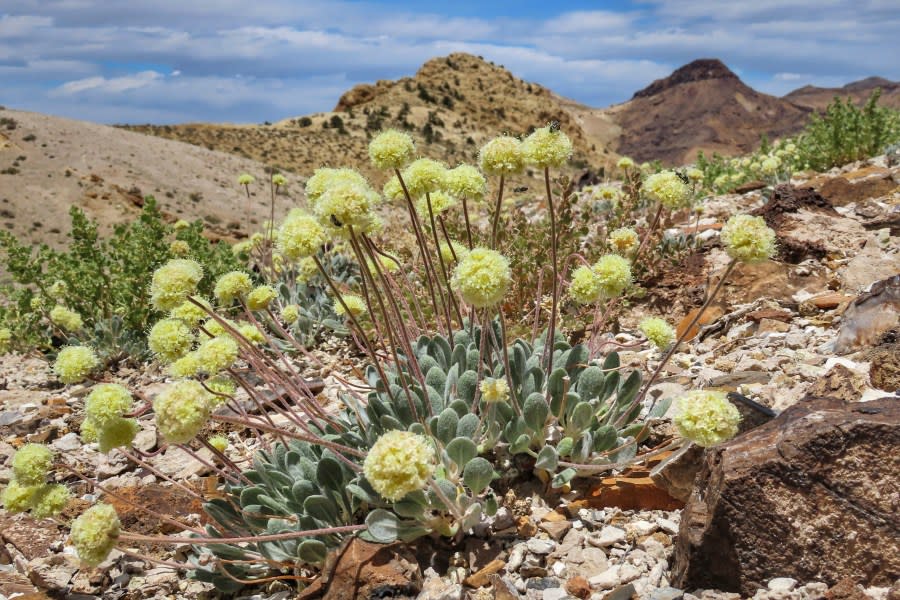‘We’ll fight it with everything we’ve got’: Stage set for battle over Nevada lithium mine, wildflower

LAS VEGAS (KLAS) — A lithium mine is on a collision course with an endangered wildflower in a remote desert area west of Tonopah.
The Bureau of Land Management (BLM) on Tuesday released a draft environmental impact statement that contains plans to protect part of the 910-acre critical habitat that was established for the plant before Australian mining company Ioneer identified the area for a lithium mine. The world’s appetite has grown for lithium to fuel the move to electronic cars and trucks, and the Biden administration has made it a priority to reduce America’s reliance on China and other countries for raw materials.
The result: a compromise that conservationists say doesn’t go far enough to protect Tiehm’s buckwheat.
“This latest plan for Rhyolite Ridge Mine is just greenwashing extinction,” Patrick Donnelly, Great Basin director at the Center for Biological Diversity, said in a news release. “Reducing the destruction of this rare plant’s habitat from 38% to 22% is like cutting off one leg instead of both. They’re still dealing a fatal blow to this precious, rare wildflower. This mine plan makes a mockery of the Endangered Species Act, and we’ll fight it with everything we’ve got.”

Donnelly has been at the front of the battle lines with Ioneer as the conflict has played out in recent years. Tuesday’s news release said the mine would push Tiehm’s buckwheat to extinction. It described the BLM’s action a rushed environmental review that “deviate[d] from other project schedules on similar projects” — a description from an internal BLM memo.
A statement issued Monday by Ioneer Executive Chairman James Calaway said, “The forthcoming release of the draft EIS represents six years of hard work to help build America’s critical minerals supply chain and reaffirms the viability of our investment in Nevada. Rhyolite Ridge will help accelerate the electric vehicle transition and secure a cleaner future for our children and grandchildren. As we move through the final steps in the federal permitting process, Ioneer will keep working to ensure this world-class project will operate efficiently and sustainably.”
Ioneer said it will be releasing its revised site design on Friday. The company has changed the quarry location and moved sites for storage to avoid impacts on Tiehm’s buckwheat.
“To date, Ioneer has voluntarily invested $2.5 million in conservation efforts and committed an additional $1 million annually to ensure the plant and its surrounding habitat are protected. Ioneer will work to ensure the plant and its habitat for pollinators are protected as it works to transplant seedlings grown at its dedicated greenhouse.
Ioneer expects the Rhyolite Ridge Lithium-Boron Project to begin operations in 24 to 36 months if the BLM’s Record of Decision comes on time in October 2024.
The only lithium mine currently operating in the U.S. is at Silver Peak, not far from the site where Ioneer intends to develop a 7,000-acre open pit mine to produce lithium and boron. The 230-page draft environmental impact statement comes a few days after BLM announced a 45-day public comment period on the project, available here.
Tiehm’s buckwheat was added to the Endangered Species Act list in December of 2022. The conflict was already apparent at that point.
The U.S. Energy Department has granted a $700 million conditional loan to Ioneer. The company was cited for trespassing on the designated Tiehm’s buckwheat habitat five days after that loan was announced.
Before that, an estimated 17,000 plants were destroyed in the area in the summer of 2020. Conservationists suspected Ioneer was behind that, but U.S. Fish and Wildlife Service officials determined that rodents were responsible.
The Center for Biological Diversity’s news release included a statement from another concerned group.
“I’m deeply concerned with the proposed mine plan, which will cause permanent, irreparable damage to Tiehm’s buckwheat’s habitat, disrupt pollinators and cause significant dust and pollution,” said Naomi Fraga, Ph.D., director of conservation at the California Botanic Garden. “For an extremely rare species confined to such a small area, no amount of destruction of its critical habitat is acceptable. The botanical community will stand together to fight back against this plan.”
Another lawsuit filed over the Thacker Pass mine site near the Nevada-Oregon border hasn’t stopped work there. Construction has started after a federal appeals court denied a request for an emergency injunction in a lawsuit filed by conservationists and tribes.
“Ioneer has already caused significant damage to Tiehm’s buckwheat’s critical habitat during mining exploration activities,” according to the Center for Biological Diversity. “Its mining operations were the chief reason cited by the U.S. Fish and Wildlife Service in declaring the species endangered in 2022.”
For more information on The BLM’s planning documents click HERE.
For the latest news, weather, sports, and streaming video, head to KLAS.

